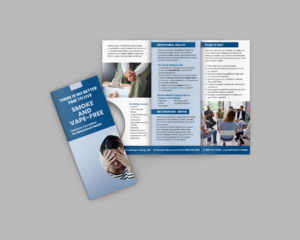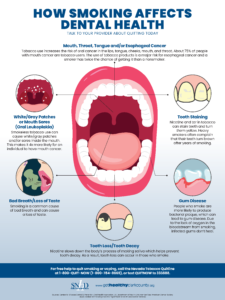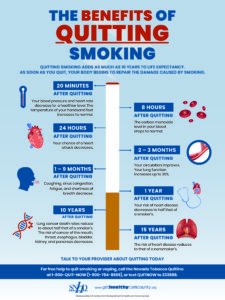
The use of tobacco products is one of the leading risk factors for various chronic diseases and death in Clark County and the U.S. As a healthcare provider, you have an opportunity to make a significant contribution to reducing tobacco use among Southern Nevada residents. We invite you and your staff to incorporate the use of brief intervention strategies when caring for patients who use tobacco products.
Tobacco use is responsible for more than 480,000 deaths annually in the U.S., resulting in more than 5.6 million years of potential life lost. According to the CDC, tobacco use in Nevada results in approximately $565 million in health care costs annually.
The health benefits of quitting smoking are substantial and include a reduced risk of heart attack, stroke, lung and other cancers, and chronic lung disease. Despite the enormous health consequences of smoking and the benefits of quitting, 14.8% of adults in Nevada continue to smoke.
Unfortunately, only about half of smokers seen by a physician report receiving advice to quit. You are in a unique position to identify tobacco users and to provide effective intervention. There is strong evidence from many clinical trials that brief smoking cessation counseling delivered by physicians, dentists, and other clinicians increases smoking cessation rates among their adult patients. We recommend health care providers routinely and consistently deliver a brief 3-step intervention consisting of “the three A’s:”
Because smokers frequently state that a healthcare provider’s advice is a strong motivator for making a quit attempt and remaining abstinent, the impact you can have on a patient’s smoking habit cannot be overstated. Please help us to reduce the use of tobacco in Nevada, so that together we can protect and improve the health of your patients and their families, by ordering the free materials and incorporating brief intervention strategies into your practice.
The Brief Intervention “5 A” approach for clinicians was developed by the Agency for Healthcare Research and Quality (AHRQ) to address tobacco use with clients regularly and efficiently. The intervention is repeated at every visit with a client and can easily be integrated into the current interaction between provider and client. The condensed approach, utilized here as a “3 A” approach, includes the following steps: Ask, Advise, and Assist. The entire intervention should take minutes.
The first step, Ask, includes asking the client about their tobacco use at every visit in order to determine if the client is a current or former tobacco user or has never used tobacco at all. The clinician will also determine the form of tobacco used and the frequency of use. The clinician should document the tobacco use status in the medical chart for quick reference at later visits. This step is often done by a nurse, or other health care provider, during other routine vital sign checks.
The second step, Advise, includes urging and encouraging every tobacco user to quit using a non-judgmental approach. Tobacco users who have failed in previous quit attempts should be reassured that it often takes repeated quit attempts before being successful long-term quitters. This step provides the clinician with an ideal opportunity to employ the teachable moment by linking medical findings or exploring the client’s current health condition and prescription usage with advice about the benefits of quitting.
The third and final step is to Assist. If it is determined during the first two steps that the client is interested and ready to quit, the clinician should link the client with appropriate resources and provide them educational materials on quitting. In Nevada, clients can be given information on the Nevada Tobacco Quitline or other cessation programs. This referral should also be documented in the client’s chart to make following up with the client at the next visit easy and convenient.
Throughout the brief intervention, it is important for health care providers not to stigmatize or be critical of tobacco users. The goal of the brief intervention is to provide resources to those who want to quit and not to impart judgment on clients.
Review the Educational Materials to see available tools and place an order. It is recommended that posters be hung in all waiting and exam rooms and that quit cards be distributed personally to clients by all clinic or hospital staff that interact with clients.
Brief tobacco use interventions work for a number of reasons:
For more information about brief tobacco use interventions, email TobaccoProgram@snhd.org or call (702) 759-1270.
The eReferral process for smoking cessation referrals helps providers overcome the manual and cumbersome process of online and fax referrals and takes advantage of electronic health record (EHR) technology. The program creates ease in both referring patients and receiving feedback information on a patient’s progress through their cessation effort. It also integrates tobacco cessation into routine clinical care and enables health systems to measure the implementation of changes and the impact of these changes on outcomes in affected patient populations.
An eReferral sends secure, two-way communication between a healthcare provider and the quitline through the patient’s EHR. Providers receive progress updates using the same system, allowing the provider to stay abreast of their patient’s progress towards quitting tobacco. All messages sent through eReferral are HIPAA-compliant to protect patient privacy.
In addition to faster referrals, using the EHR improves data quality and increases the likelihood of a successful referral to a qualified tobacco cessation provider. The benefits of transitioning to an eReferral system include developing a sustainable, cost-effective system that has possibilities of reaching higher numbers of patients and ultimately, improve patient outcomes.
If you are interested in exploring an eReferral connection for your clinical setting in Southern Nevada, the Southern Nevada’s Health District’s Tobacco Control Program is offering technical assistance. Please reach out to Cassandra Meraz at meraz@snhd.org or call (702) 759-1262 to learn more.
The role of the Quitline in the Brief Intervention program cannot be emphasized enough. The Quitline is the only statewide phone-based and online resource to which health care providers can refer; and as a free cessation service, it appeals to many people.
The Nevada Tobacco Quitline is a free phone-based and online coaching service for any Nevada resident who is ready to quit tobacco. Information, referrals and coaching are confidential, and sessions are designed on a schedule that is convenient for quitters. For those that are eligible, free Nicotine Replacement Therapy is available to assist with the quit attempt.
The Nevada Tobacco Quitline is available 7 days a week, 24 hours a day. For more information, visit the Nevada Tobacco Quitline website.
Posters, brochures and quit cards are available in English and Spanish. It is recommended that posters be hung in any and all waiting and exam rooms and that quit cards and brochures be distributed personally to clients by all clinic or hospital staff that interact with clients.
To order free materials visit our online store or contact the Tobacco Control Program at (702) 759-1270.










